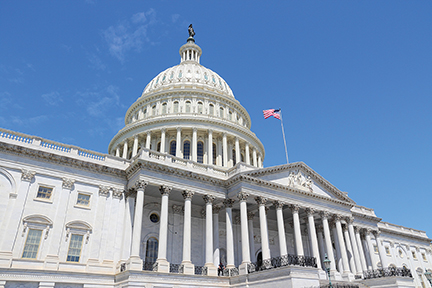Religious Makeup of Congress
According to a recent analysis by Pew Research Center (with data compiled by CQ Roll Call), Congress remains mainly Christian — with 91% of members of the new 115th Congress identifying as Christians. This percentage is similar to the initial years that this data was collected, in 1961-1962. In those years, the 87th Congress was 95% Christian. Both Republicans and Democrats in the new Congress are largely Christian. Among Republicans, 291 of the 293 identify as Christian, with the remaining two identifying as Jewish. Of Democrats, around 80% identify as Christian, with the other 20% identifying as Jewish, Buddhist, Hindu, Muslim and Unitarian Universalist; 10 Democrats declined to identify their religion, while one has stated herself as “religiously unaffiliated.”

Within parties, 99% of Republicans identify as Christian; this is a larger representation than the general public, where 82% of adults who either identify as Republican or lean towards the party are Christian. Sixty-seven percent (of the 99%) of the Republicans in Congress identify as Protestant. Democrats are 80% Christian, with 42% identifying as Protestant. Thirty-seven percent of Christian Democrats identify as Catholic.
Catholics, Protestants and Jews actually have more representation in Congress than in the US population; an example of this is those who identify as Jewish represent 6% of Congress, but in the general population, they represent only 2%. Christians represent 91% of Congress but account for only 71% of US adults.
Analysis shows that those who identify as “unaffiliated,” or “nones,” are the most underrepresented in Congress. While 23% of the general population says they are “unaffiliated,” only 0.2% of Congress identifies as unaffiliated.
For the newest Congress, Protestants lost seven seats, while Catholics gained four. Mormons lost three seats, with their total being 13. Orthodox Christians, at five, remained the same. Christians, in general, lost only six seats from the 114th Congress to the current 115th. Non-Christian groups had some gains, with Jews and Hindus each increasing by two seats. For Jews, this brings their total to 30 seats, and Hindus now hold three seats. Buddhists gained one seat (for three seats total). Muslims stayed the same at two seats.
Although little has changed, percentage-wise, from the initial findings of the 87th Congress in 1961 to our present 115th Congress (95% Christian to current 91% Christian), there have been some internal changes. Protestants now represent 56% of Congress, compared to 75% in 1961. Catholics now make up 31% of Congress; but in the 87th Congress, they made up 19%.
Top findings on church expansion
Barna Group and Cornerstone Knowledge Network (on behalf of Aspen Group and Fishhook) recently conducted research on the current culture of church planting. They compiled their research — collected from pastors / leaders who have chosen to have church plants — and created a list of what they discovered.

Firstly, Barna’s findings showed many differences in strategies and models of church planting. However, when categorized by number of locations and whether they consider themselves to be multisite (part of a single church) or a church plant (intended to be their own independent church in the future), there were distinctions. Churches usually fell in to one of five categories: Multisite Beginner (two or three locations with one single church); Planting Beginner (two or three partly independent churches, which are considered church plants); Multisite Strategist (one church with four or more locations); Planting Strategist (four or more partly independent churches — which are considered church plants); and Location Partner (a separate congregation meeting at the same location and sharing resources with another church). Geographical outreach, mission and calling were the top three reasons for expansion. Concerns of growth and accommodation only represented a small percentage of the reason that Planting Beginners started expansion, at 4%. Differences between the categories exist in the reasons for expansion. At 43%, Multisite Strategists are more interested in geographical reach than Planting Strategists, at 23%. The difficulty of church expansion is evident across categories. One-third rate it as being “harder than anticipated,” with 44% of those focused on multisite strategizing topping the list as the highest percentage that thought it was “harder than anticipated.” This is most likely due to increased complication at coordinating multiple sites.
One out of five of churches has closed or cut off ties with a location, for various reasons. A high percentage of closings (82%) are because of low attendance. Other reasons include leadership issues / turnover (32%) and financial problems (21% because of insufficient giving, 29% because of the location being too expensive to maintain). However, when some locations have decided to split ties (not close) with a church, 48% state that it is because the new location is self-sustaining and autonomous.
A finding on what defines “multisite” and “church plant” shows that the name is a big determining factor. Planting Strategists, at 23%, and Planting Beginners, at only 10%, kept the same name as the sending church. This is relatively low compared to Multisite Strategist (65%) and Multisite Beginner (58%), who largely keep the same name. For the Planting Strategists, Planting Beginners and Location Partners, a different identity is often established. Of those who decided to have plants establish their own type of branding, 72% state that they believe this gives the leaders of the plants more ownership of their church or campus — something they view as positive.
One-third of pastors believe the new church provided a revitalization for the congregation, with 50% saying that the opening of a separate location benefits surrounding communities. Another benefit pastors who established church plants identified is more opportunities for lay leader development (75%). Negatively, expansion also revealed leadership gaps, which pastors say was a negative impact (23%). As far as priorities for the new sites / plants, leaders focused on youth ministries as a top priority, with all categories giving it above 60% of their focus.
Planting Beginners, at 72%, stated that they depended on increased giving provided by the continuous increased growth, otherwise known as “self-funding.” Sixty-six percent of Planting Strategists use this method, but also had a percentage of their operation budget dedicated to growth. They also are not likely to wait until the funds are needed to start raising them. Twenty percent of Planting Beginners use capital campaigns, and 26% wait until the funds are needed.
Overall, 39% of pastors say more “unchurched” people checked out their church because of expansion. Meanwhile, 30% say it created new growth, and 20% say it accelerated growth. The remaining 10% say it shifted people away from other churches to try their new church.
The relationships of pastors
Barna, in partnership with Pepperdine University, conducted a study on faith leaders and their personal relationships. They wanted to explore if the pressures that they face in their profession have an impact on these relationships. Out of the 96% of pastors who are married, 70% say they have an excellent relationship with their spouse, while 26% find it ‘good.’ In comparison, of the general population, 46% of married adults state their relationship is excellent, while 35% say it is good. Likewise, divorce rates differ: 27% of US adults have been divorced, while 10% of Protestant pastors have been divorced. Financially, those who made less money have a strong relationship with their spouse — 83% who make $40,000 or less state that their marriage is excellent.

For pastors who are parents to children under 18 (35%), 60% say their relationship with their kids is excellent and 36% rate it as good. This, again, is higher than the general population: 46% say their relationship with their kids is excellent, and 32% say it’s good. Forty-two percent of pastors stated that they would like to spend more time with their kids.
Findings on marital problems show that about 26% of pastors report having significant issues, and 27% say they have had issues parenting. Age is a factor — pastors over 50 reported these problems at a higher rate, possibly because of the longer amount of time that their relationships were established.
Friendships seemed to function well, with 67% stating that they were either excellent or good. However, this concludes that one-third are dissatisfied with their friendships. These friendship statistics are similar to the statistics for US adults (61% have excellent or good relationships). Pastors were also asked about “having true friends.” Pastors 50 and older were more likely to rate their level of satisfaction with “having true friends” as excellent. This rang true for those who had been in ministry 30 years or longer or at their church 10 years or longer — they were more likely to rate “having true friends” as excellent.
Concerning spiritual support, most pastors received direct support monthly (68%) or “several times a month or more often” (37%).


